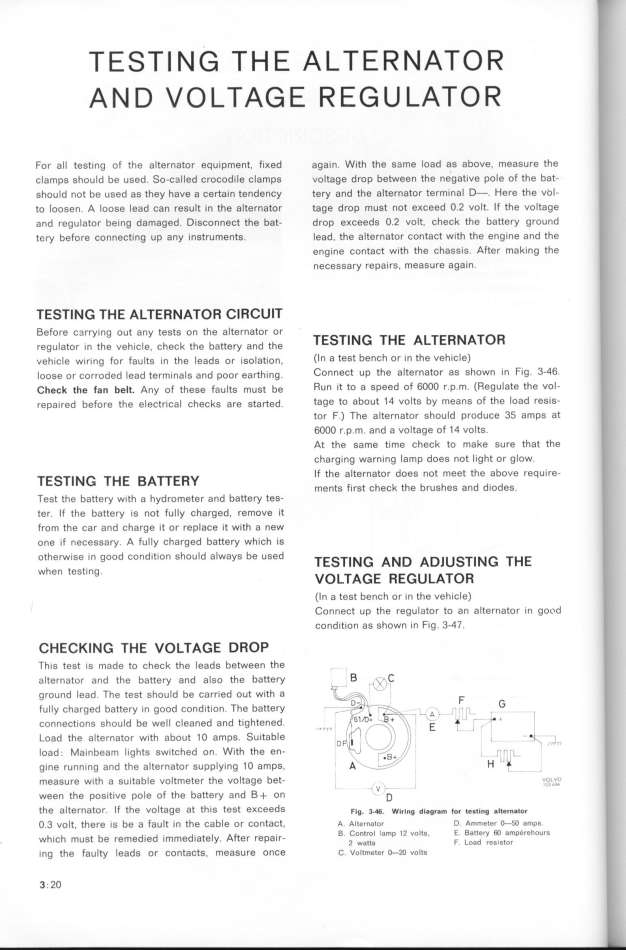 |

|
 |


Begin OCR Text:
_A
E_
__
_ v
_ _o
__ _
_A
H_
EE
A_
_E
__
e _u
__ A
A_
_o
o _
_
for all testing of the alternator eQuipment, fixed again. With the same load as above, measure the
clamps should be used. So_called crocodile clamps voltage drop between the negative pole of the bat-
should not be used as they have a certain tendency tery and the alternator terminal D-. Here the vbl_
to loosen. A loose lead can result in the alternator tage drop must not eKceed O.2 volt. lf the voltage
and regulator being damaged. Disconnect the bat_ drop eKceeds O.2 uolt, check the battery ground
tery before connecting up any instruments. Iead. the alternator contact with the engine and the
engine contact with the chassis. After making the
necessary repairs. measure again.
TESTING THE ALTERNATOR CIRCUIT
Before c3rrying out any tests on the alternator or TE_i_ NG THE AiTERNAToR
regulator in the vehicle, check the battery and the
vehiÁ_e wiring for fau_tg in the _eadg or igo_ation. (ln a teSt benCh or in the vehiCle)
_ooge or corroded _ead term_na_g and poor earthing. ConneCt up the alternator as shown in fig. 3-46_
__eÁk t_e _a_ be__. Any of thege fau_tg mugt be Run it to a Speed of 6OOO r.p.m. (RegUlate the Vol_
repaired before the e_ectrica_ ÁheÁ_g are gta_ed. tage to about 14 volts by means of the load resis-
tor F.) The alternator should produce 35 amps at
6OOO r.p.m. and a voltage of 14 volts.
At the same time check to make sure that the
charging warning lamp does not light or glow.
iEST_ NG iH E _AiTERy If the alternator does not meet the above require-
ments first check the brushes and dŪodes.
Test the battey with a hydrometer and battey tes-
ter. lf the battery is not fully charged. remove it
from the car and charge it or replace it with a new
one if necessay. A fully charged battery which is
otherw_se in good condition should always be used ieST_ NG AN D AD_uSi_ N G iHE
when teSting. voiiAGE ReGuiAioR
(ln a test bench or in the vehicle)
Connect up the regulator to an alternator in goL_d
condition as shown in Fig. 3-47.
CHECKl NG TH E VO LTAGE DROP
This test _s made to check the leads between the
alternatur and the battery and also the battery
.
ground lead. The teet should be carried out with a F
Fu__y Áharged battery _n good Áond_tion _he battery , , , _ , G
' _ L A '_ _ _ - _ _
connectžons should be well cleaned and tightened. , , ) l _E _ __. _, ' _1
toad the alternator with about 1 O amps. Suitable ,l _ _ ,_,,
load . Mainbeam lights switched on. With the en- ' , ,_ __ r_ _
'
gine running and the alternator supplying 1 O amps, H _
measure with a suitable uoltmeter the voltage bet- ' _vuLvu
f b B _ _ V -- ' ''''''
Ween the pOSltiVe pole O the attery and + On D
the alternator. If the voltage at this test e_ceeds F;g. 3-_. w_,_,g di,g,,_ _o, (e,(;,g ,i(e,,,(,,
O.3 volt, there is be a fault in the cable or contact, A. A_(ern8(or o Amme(er __ amps
h h t b d_ d _ d_ t _ A_ B Control lamp 12 Voltg, E Battefy 6O ampirehoUrS
W l« mUS e reme le Imme la e y. er fepalr- _ wa((g F _oad _eg._g(o,
_ng the faulty leadS or contaCts, measure or)ce C vo_(me(er __ voI(s '
3; 2O
|

